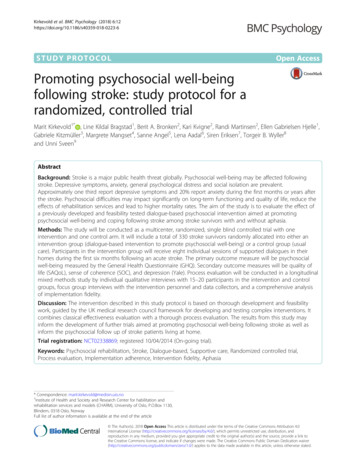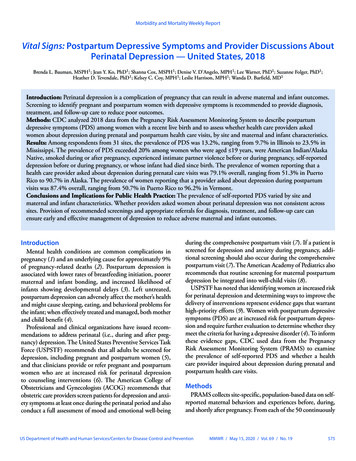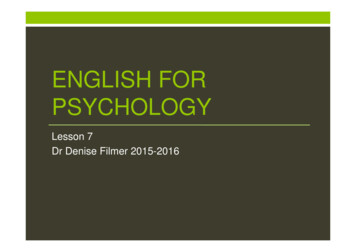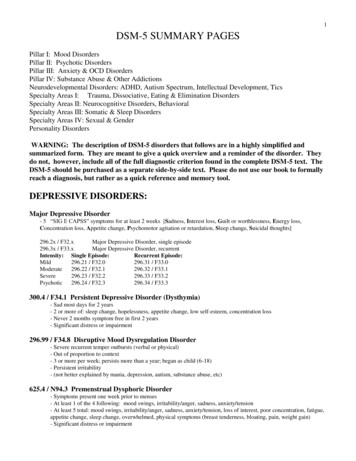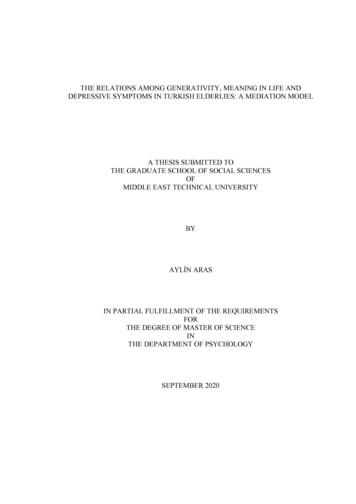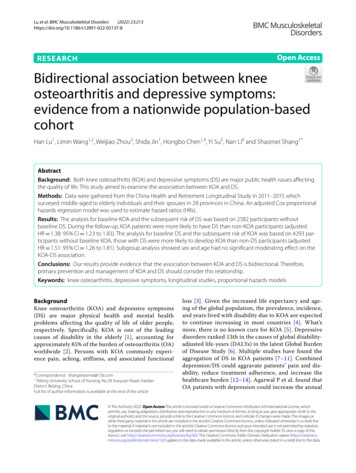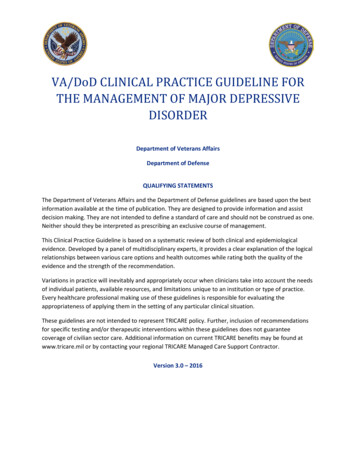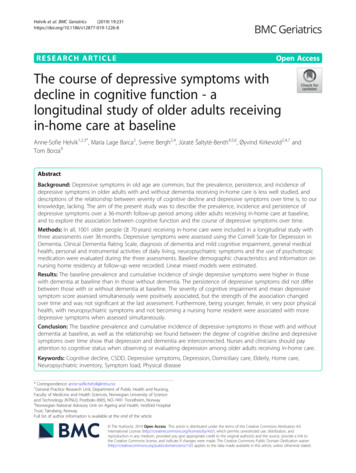
Transcription
Helvik et al. BMC Geriatrics(2019) EARCH ARTICLEOpen AccessThe course of depressive symptoms withdecline in cognitive function - alongitudinal study of older adults receivingin-home care at baselineAnne-Sofie Helvik1,2,3*, Maria Lage Barca2, Sverre Bergh2,4, Jūratė Šaltytė-Benth4,5,6, Øyvind Kirkevold2,4,7 andTom Borza4AbstractBackground: Depressive symptoms in old age are common, but the prevalence, persistence, and incidence ofdepressive symptoms in older adults with and without dementia receiving in-home care is less well studied, anddescriptions of the relationship between severity of cognitive decline and depressive symptoms over time is, to ourknowledge, lacking. The aim of the present study was to describe the prevalence, incidence and persistence ofdepressive symptoms over a 36-month follow-up period among older adults receiving in-home care at baseline,and to explore the association between cognitive function and the course of depressive symptoms over time.Methods: In all, 1001 older people ( 70 years) receiving in-home care were included in a longitudinal study withthree assessments over 36 months. Depressive symptoms were assessed using the Cornell Scale for Depression inDementia. Clinical Dementia Rating Scale, diagnosis of dementia and mild cognitive impairment, general medicalhealth, personal and instrumental activities of daily living, neuropsychiatric symptoms and the use of psychotropicmedication were evaluated during the three assessments. Baseline demographic characteristics and information onnursing home residency at follow-up were recorded. Linear mixed models were estimated.Results: The baseline prevalence and cumulative incidence of single depressive symptoms were higher in thosewith dementia at baseline than in those without dementia. The persistence of depressive symptoms did not differbetween those with or without dementia at baseline. The severity of cognitive impairment and mean depressivesymptom score assessed simultaneously were positively associated, but the strength of the association changedover time and was not significant at the last assessment. Furthermore, being younger, female, in very poor physicalhealth, with neuropsychiatric symptoms and not becoming a nursing home resident were associated with moredepressive symptoms when assessed simultaneously.Conclusion: The baseline prevalence and cumulative incidence of depressive symptoms in those with and withoutdementia at baseline, as well as the relationship we found between the degree of cognitive decline and depressivesymptoms over time show that depression and dementia are interconnected. Nurses and clinicians should payattention to cognitive status when observing or evaluating depression among older adults receiving in-home care.Keywords: Cognitive decline, CSDD, Depressive symptoms, Depression, Domiciliary care, Elderly, Home care,Neuropsychiatric inventory, Symptom load, Physical disease* Correspondence: anne-sofie.helvik@ntnu.no1General Practice Research Unit, Department of Public Health and Nursing,Faculty of Medicine and Health Sciences, Norwegian University of Scienceand Technology (NTNU), Postboks 8905, NO-7491 Trondheim, Norway2Norwegian National Advisory Unit on Ageing and Health, Vestfold HospitalTrust, Tønsberg, NorwayFull list of author information is available at the end of the article The Author(s). 2019 Open Access This article is distributed under the terms of the Creative Commons Attribution 4.0International License (http://creativecommons.org/licenses/by/4.0/), which permits unrestricted use, distribution, andreproduction in any medium, provided you give appropriate credit to the original author(s) and the source, provide a link tothe Creative Commons license, and indicate if changes were made. The Creative Commons Public Domain Dedication o/1.0/) applies to the data made available in this article, unless otherwise stated.
Helvik et al. BMC Geriatrics(2019) 19:231IntroductionDepression is a frequent cause of emotional suffering inold age, and it may also contribute to reduced physicalfunctioning, reduced quality of life [1–3], increased riskof nursing home admission [4], and reduced life expectancy [5, 6]. Depression in old age is also related tohigher health care costs [7].A population-based meta-analysis found the diagnosticpooled prevalence of depression in older adults to beabout 7% [8]. A review of population-based studies ofolder adults with mild cognitive impairment (MCI) reported the prevalence of diagnosed depression in thesestudies to vary between 11 and 40% [9]. In a Europeanstudy that included data from older adults with dementiain eight countries who were receiving in-home care, thepooled prevalence of clinically significant depressivesymptoms, defined as 10 on the Cornell Scale for Depression in Dementia, was 34% [10]. The prevalence ofclinically significant depressive symptoms in older adultswith dementia receiving in-home care varied from 11 to60% between countries [10, 11]. In some countries thereported prevalence was higher in individuals receivingin-home care than in nursing home (NH) residents [10],but not in all [10, 11]. The prevalence of depression andclinically significant depressive symptoms, as well as thepersistence, incidence and remission of depression anddepressive symptoms has been extensively explored inNH residents [12, 13], compared to older adults who liveat home and receive care. To our knowledge, there areno reports of studies that provide a detailed descriptionof the prevalence, persistence, incidence and remissionof individual depressive symptoms in older adults receiving in-home care in the Nordic countries or Norway.However, this information is important for politiciansand health care planners in these countries as they planfor providing adequate care for older adults in need ofin-home care. The Cornell Scale for Depression in Dementia (CSDD) [14], which is validated for use in peoplewith and without dementia [14–17] and is widely usedin clinical settings and research [18–20], is a useful toolto assess depressive symptoms among older adults receiving in-home care.A review of studies of the course of depression in community dwelling and general practice people has reportedthat one of three people develop a chronic depressivecourse [21]. The same review found that factors associatedwith persistent depression in older community-dwellingresidents were greater age, high external locus of controland baseline physical co-morbidity, functional limitations,and more severe depressive symptoms, but the evidencewas inconclusive when it came to an association betweendementia and persistent depression [21]. However, dementia and depression commonly coexist [22], and both ahistory of depression and use of antidepressants have inPage 2 of 14reviews been found linked to increased risk for dementia[23, 24]. Furthermore, depressive symptoms may presentsomewhat differently in people with dementia comparedto people without dementia [25]. Not all people with MCIdevelop dementia, but a review of studies exploring depression in older adults with MCI concluded that MCIcould be the earliest identifiable clinical stage of dementia,and argued that the underlying neuropathological condition causing MCI or dementia may also cause depressivesymptoms [9]. It is possible that late-life depression couldbe an early cause prodromal sign of dementia, especiallybecause pathological changes associated with dementingdiseases can begin long before their clinical onset [6].Thus, the course of depressive symptoms in older adultsreceiving in-home care is of particular interest and maygive us a better understanding of the relationship betweencognitive decline, and the course of depressive symptoms.In clinical practice, dementia may be mistaken for depression due to lack of initiative and limitations in personaland instrumental activities of daily living.To explore the course of depressive symptoms, wehave carried out a longitudinal, large-scale study of agroup of older adults receiving in-home care at baseline,with three assessments over 36 months. The first aim ofour study was to describe the prevalence, incidence andpersistence of depressive symptoms over the follow-upperiod, and the second aim was to explore the association between cognitive function and the course ofdepressive symptoms. A detailed description of theprevalence, persistence, incidence and remission of individual depressive symptoms in older adults receiving inhome care is of clinical importance for nurses and othercaregivers providing the in-home care. Furthermore, it isof interest to explore the relationship between cognitivefunctioning and depressive symptoms to improve treatment and follow-up. Politicians and health care plannerswill favour such knowledge to provide sufficient care forolder adults in need of in-home care.MethodsStudy designThis longitudinal study, with a 36-month follow-upperiod, collected baseline information between August2008 and December 2010. The follow-up assessmentswere after 18 and 36 months, last follow-up January2014 [26].ParticipantsIn total, 1796 individuals (age 70 years) from 19 small,medium and large municipalities in five counties in theeastern part of Norway were invited to participate in thestudy. All participants had to be receiving in-home care,aged 70 years and have a next of kin who saw them atleast once a week. No further exclusion criteria were
Helvik et al. BMC Geriatrics(2019) 19:231included. Participants were both established and newusers of in-home care. Established users were drawnfrom the lists of care service providers and new userswere included successively. These services could typically include ‘meals on wheels’, safety alarm, practical aid,day-care centre, mental health care or in-home nursing.The individuals were invited regardless of amount andkind of service received.Of the total 1796 people invited, 795 declined to participate, leaving 1001 people in the study. Those who declined participation were more often female and olderthan those included in the study [26, 27].MeasuresDepressive symptoms (dependent variable) were assessedwith the Cornell Scale for Depression in Dementia(CSDD) at all assessments [14]. The CSDD was scoredby a research assistant after an interview with the patient’s primary caregiver. The CSDD consists of 19items, with each item rated as 0 (absent), 1 (mild), 2 (severe) or “symptom is not possible to evaluate”. If morethan 20% of the items in CSDD were scored as “not possible to evaluate”, the participant was excluded from theanalysis, otherwise the item response was set to missing.Since symptoms that are not possible to evaluate maycontribute to reducing the sum-score, a mean-score ofthe scale was used. A clinically significant symptom levelindicating depression was defined as a mean CSDDscore higher than 0.42, which is equivalent to a sumscore cut-off of 9 and higher for CSDD.The levels of personal and instrumental functioningwere reported by next of kin and classified using Lawtonand Brody’s Physical Self-Maintenance Scale (P-ADL)and Instrumental Activities of Daily Living Scale (IADL). The P-ADL sum-score is based on six items(range 6–30), where higher scores indicate a lower levelof functioning, while the I-ADL sum-score is based oneight items (range 0–8), where a higher score indicatesbetter I-ADL functioning [28]. These scales are amongthe shorter scales that are recommended to assess PADL and I-ADL [29], are frequently used in Norwegianand Scandinavian studies [30, 31] and are suitable foruse in community-living older persons as well as in NHresidents [32, 33].Cognitive function and dementia severity symptomswere evaluated by the following tools: Mini-Mental StateExamination (MMSE) [34], Clock-Drawing Test (CDT)[35], the Informant Questionnaire on Cognitive Declinein Elderly (IQCODE) [36] and Clinical Dementia RatingScale (CDR). The CDR includes six domains; memory,orientation, judgement and problem solving, communityaffairs, home functions, and personal care. An algorithmgives a total score of 0, 0.5, 1, 2 or 3, indicating respectively; no dementia, possible dementia, and mild,Page 3 of 14moderate and severe dementia [37]. In the present study,we used CDR sum of boxes (CDR-SoB), with a scoreranging from 0 to 18, where a higher score indicatesmore severe cognitive decline [38]. The assessment toolsfor cognitive function and severity of dementia havebeen translated and validated in Norwegian [39–41].The research assessors completed the CDR scale basedon all collected information.Neuropsychiatric symptoms were evaluated using theNeuropsychiatric Inventory (10-item NPI) [42] in a translated and validated Norwegian version [43]. The 10-itemversion covers the following symptoms: delusion, hallucination, euphoria, agitation/aggression, disinhibition, irritability/lability, depression/dysphoria, anxiety, apathy/indifference, and aberrant motor behaviour. Three subsyndromes of NPI; “Agitation”, “Psychosis”, and “Affectivesymptoms”, have previously been reported using the sample in the present study [44]. “Agitation” includes theitems agitation/aggression, euphoria, disinhibition, aberrant motor behaviour and irritability; “psychosis” includesthe items delusions and hallucinations. “Affective symptoms” includes the items depression, anxiety, and apathy.Dementia and mild cognitive impairment (MCI) were diagnosed independently by two experienced physicians ingeriatric psychiatry at all three assessments based on allavailable information. Diagnoses of dementia were madeaccording to the ICD-10 criteria [45] and MCI according tothe Winblad criteria [46]. In cases of disagreement, consensus was reached after consulting a third clinical expert.Physical health was evaluated using the General Medical Health Rating Scale (GMHR), considering the patient’s number and severity of medical conditions andthe use of medication due to these conditions. GMHR isscored from 1 to 4, where 1 indicates very poor physicalhealth and 4 indicates good physical health [47].Data on the participants’ use of drugs were collectedfrom medical records. Drugs were divided into groups according to the Anatomical Therapeutic Chemical (ATC)Classification System [48]. Psychotropic drugs were categorized as antipsychotics (N05A except lithium), anxiolytics (N05B), hypnotics/sedatives (N05C), antidepressants(N06A), and anti-dementia medication (N06D). Use ofmedication was dichotomized into yes or no. Medicationdosages were not available for the present study.The formal level of care at follow-up assessments wasrecorded as location, i.e. community-dwelling receivingin-home care or NH care.Demographic data including age, gender, municipalityof residence and marital status were recorded in thebaseline assessment.ProcedureThe process of collecting data was led by a researchnurse who cooperated with assessors in the different
Helvik et al. BMC Geriatrics(2019) 19:231municipalities. The majority of the assessors werenurses, social educators and occupational therapists. Allassessors took a two-day training course on how to usethe assessment scales before the baseline data collectionbegan. A one-day training course was conducted priorto the second and third assessments. The participantsand their next of kin were interviewed simultaneously bytwo separate research assessors. Further information regarding the data collection is published elsewhere [27].Study information, both oral and written, was given tothe participants and their next of kin. Written informedconsent was required from both the participant and theirnext of kin before the interviews were carried out. Inthose lacking capacity to consent, their closest familyproxy gave their informed consent on behalf of theirnext of kin. The Regional Committee for Medical andHealth Research Ethics for Eastern Norway (S-08111b),the Norwegian Social Science Data Services (NSD) (07–2008SI), and the Directorate for Health and Social Affairs (08/2984) approved this study.Page 4 of 14and Affective, use of antipsychotics, antidepressants, anxiolytics, sedatives, and cognitive enhancers in bothmodels; admission to NH only in Model 2) one at thetime. Covariates measured at baseline were included inModel 1, while covariates measured simultaneously withCSDD whenever possible were included in Model 2. Inthis way, Model 2 takes into account the dynamics inboth outcome and covariates. Finally, multiple modelsthat included all covariates were estimated and reducedby applying Akaike’s Information Criterion (AIC), wherea smaller value means a better model. All models contained random intercepts for participants nested withinmunicipality and random slope for time. Prior to regression analyses, correlations among assessed variables wereevaluated to identify possible multicollinearity issues.Statistical analyses were performed in SAS v 9.4 andSPSS v 25. Results with p-values below 0.05 were considered statistically significant.ResultsSample characteristicsData analysisSample characteristics at baseline were presented asmeans and standard deviations (SD) or as frequenciesand percentages. For analyses on the course of depressive symptoms, the 19 CSDD items were dichotomizedto present (rating of 1 or 2) or absent (rating of 0).Prevalence, incidence, cumulative incidence and persistence were calculated for each depressive symptom andcompared between participants with dementia and participants without dementia with a generalized linearmixed-model adjusted for within-municipality correlations. Prevalence was defined as the proportion ofresidents with the symptom present at an individual assessment. Incidence rate was defined as the ratio of residents who presented the symptom at one assessment tothose who were symptom free at the preceding assessment. Cumulative incidence was reported as incidencethroughout the whole study period. Persistence rate wascalculated as the ratio of residents who presented thesymptom at one assessment to those who presented thesymptom at the preceding assessment.To assess if the severity of the cognitive impairment/dementia (CDR-SoB) was associated with mean depressive symptoms (CSDD) over time, two linear mixedmodels were estimated. Model 1 for CSDD measured atbaseline contained fixed effects for baseline CDR-SoB,while CDR-SoB measured simultaneously with longitudinally assessed CSDD was included as a fixed effect inModel 2. Bivariate models with time, CDR-SoB andinteraction between those two were estimated first. Next,the models were adjusted for pre-defined covariates(gender, age, single, GMHR, P-ADL, I-ADL, Neuropsychiatric sub-syndrome score for Agitation, PsychosisOf the 1001 participants at baseline (T1), 46 (4.5%) were excluded due to missing data for CSDD (20% or more of singleitems were not possible to evaluate) at baseline. Among theremaining 955 participants, 394 (41.2%) had dementia, 266(27.9%) had MCI and 295 (30.9%) had no cognitive impairment at baseline, and the mean (SD) age was 83.4 (5.6) years(see Table 1). In all, 653 (68.4%) of the participants werewomen, 287 (30.1%) were married and 149 (15.6%) had agood physical health based on the GMHR. The mean (SD)baseline CDR-SoB was 3.2 (3.8). At follow-up, 511 (53.5%)and 417 (43.7%) of the 955 participants analysed at baselinewere available for analyses at the second and third assessments (T2 and T3), respectively (see Fig. 1). At follow-up, 82participants (16.1%) and 100 participants (24.0%) had beenadmitted to a NH at T2 and T3, respectively.Prevalence, incidence and persistence of single symptomsof depression and clinically significant symptom levelsThe prevalence of depressive symptoms at baseline and atfollow-up is presented in Table 2. The two most prevalentsingle symptoms reported by the CSDD at baseline wereanxiety (35.9%), and multiple physical complaints (35.2%).The prevalence at T2 and T3 were 36.3 and 33.5%, and 37.5and 29.8% for anxiety and multiple physical complaints, respectively. At all assessments, anxiety symptoms were significantly more prevalent in participants with dementia atbaseline than in those without dementia (MCI or no cognitive impairment). The prevalence of multiple physical complaints did not differ between residents with and withoutdementia for any assessment. The least frequent symptomsat baseline were delusion (5.6%), suicidal ideation (5.6%) andagitation (5.8%) and the prevalence of these symptoms wasquite similar at T2 and T3. At baseline, 19.3% had a clinically
Helvik et al. BMC Geriatrics(2019) 19:231Page 5 of 14Table 1 Sample characteristics at baseline (N 955)AllN 955No MCI or DementiaN 295MCIN 266DementiaN 394Socio-demographicsAgeMean (SD)83.4 (5.6)81.7 (5.6)83.4 (5.4)84.6 (5.5)FemalesN (%)653 (68.4)202 (68.5)188 (70.7)263 (66.8)aN (%)287 (30.1)81 (27.5)80 (30.2)126 (32.0)GoodN (%)149 (15.6)67 (22.7)42 (15.8)40 (10.2)Fairly goodN (%)378 (39.6)127 (43.1)109 (41.0)142 (36.1)PoorN (%)326 (34.2)80 (27.1)93 (35.0)153 (38.9)MarriedHealth conditionGMHRaVery PoorP-ADL scorebN (%)101 (10.6)21 (7.1)22 (8.3)58 (14.8)Mean (SD)9.1 (3.5)7.6 (2.1)8.4 (3.0)10.8 (4.0)I-ADL scorebMean (SD)5.2 (2.4)6.6 (1.6)5.9 (2.0)3.6 (2.2)CDR-SoBMean (SD)3.2 (3.8)0.8 (1.4)1.6 (2.0)6.1 (4.0)AgitationcMean (SD)1.7 (4.6)0.7 (2.7)1.1 (3.1)2.8 (6.1)cMean (SD)0.5 (2.0)0.1 (0.5)0.2 (1.5)1.1 (2.8)Mean (SD)2.9 (5.3)1.1 (2.6)2.2 (3.9)4.7 (6.8)AntipsychoticsN (%)36 (3.8)5 (1.7)7 (2.6)24 (6.1)AntidepressantsN (%)148 (15.5)32 (10.9)38 (14.3)78 (19.8)AnxiolyticsN (%)84 (8.8)15 (5.1)27 (10.2)42 (10.7)SedativesN (%)211 (22.1)54 (18.3)59 (22.2)98 (24.9)Neuropsychiatricsub-syndrome scorePsychosisAffectivecUse of psychotropicmedicationCognitive enhancersNo of drugsN (%)54 (5.7)04 (1.5)50 (12.7)Mean (SD)5.4 (2.9)5.1 (3.1)5.4 (2.8)5.5 (2.9)MCI Mild Cognitive Impairment, GMHR General Medical Health Rating Scale, P-ADL Personal functioning assessed with Lawton and Brody’s Physical Self-MaintenanceScale, I-ADL Instrumental functioning assessed with Instrumental Activities of Daily Living Scale, CDR-SoB Clinical Dementia Rating Scale with sum of boxesaMissing information from one participantbMissing information from three participantscMissing information from two participantssignificant symptom level indicating depression, i.e. a meanCSDD score higher than 0.42, which was equivalent to asum-score cut-off of 9 and higher at CSDD. The cumulativeincidence of a clinically significant symptom level after baseline was 15.6%. The cumulative incidence of eight items onthe CSDD scale (lack of joy, irritability, retardation, lack ofinterest, multiple awakening, early morning awakening, poorself-esteem and delusions) was higher for those with dementia than without dementia.The persistence of clinically significant levels of depressive symptoms between T1 and T2 was 34.7%,while the persistence between T2 and T3 was 24.6%.Only one depressive symptom, irritability, was morepersistent between T1 and T2 for those with dementiaat baseline (65.8%) than for those without (43.9%).The symptom pessimism was more persistent betweenT2 and T3 in those without dementia at baselinecompared to those with dementia, i.e. 58.1 and 30.3%,respectively.Mean depressive symptoms score over the follow-upperiodThe overall mean CSDD score decreased over the 36month follow-up (Table 3 and Fig. 2). Unadjusted forcovariates, there was a significant linear reduction inmean CSDD score through the study period (p 0.015),by an average of 0.001 points per month.Association between dementia and mean depressivesymptom scoreThe association between the severity of cognitive decline,assessed with the CDR-SoB and the mean CSDD scoreover time was studied in two multiple models. In multipleModel 1 (see Table 4), the association between CDR-SoB
Helvik et al. BMC Geriatrics(2019) 19:231Page 6 of 14Fig. 1 Flowchart for participants over 36 monthsat T1 and mean CSDD score changed over time (p 0.001for interaction). More severe cognitive impairment was associated with a higher mean CSDD score at T1, with theassociation significant for values of CDR-SoB of 3 orhigher and becoming somewhat stronger with increasingvalues of CDR-SoB (p 0.001). However, this associationwas not significant at T2 and at T3 (Fig. 3).In multiple Model 2, the association between CDR-SoBand mean CSDD score assessed simultaneously at threetime points also changed over time (p 0.001 for interaction). The association was positive and significant forvalues of CDR-SoB of 2 or higher, and became somewhatstronger with increasing values of CDR-SoB at both T1and T2 (p 0.001), but was not significant at T3 (Fig. 4).In both multiple models, being female, younger, andhaving a higher level of agitation and affective sub-syndrome score were associated with a higher score on theCSDD scale. In addition, in multiple Model 1, usingsedatives and having a lower I-ADL score at baseline wereassociated with higher score on the CSDD scale throughout the follow-up. In Model 2, having very poor, as compared to good, physical health and not being a NHresident at T2 and T3 were associated with a higher scoreon the CSDD scale when measured simultaneously.DiscussionThe present study describing the prevalence, incidenceand persistence of depressive symptoms over a 36-month follow-up period among older adults receivingin-home care at baseline, and found that both the baseline prevalence and cumulative incidence of depressivesymptoms were higher in those with dementia at baseline than in those without dementia at baseline. However, the persistence of single depressive symptoms didnot differ between those with or without dementia atbaseline. When exploring the association between cognitive impairment and the course of depressive symptomsover time, we found a positive association between theseverity of cognitive impairment and mean depressivesymptoms assessed simultaneously. Furthermore, wefound that the association changed over time and wasnot significant at the last follow-up, 36 months afterbaseline. In the same analysis, being younger, female, invery poor physical health, with more neuropsychiatricsymptoms and not being a NH resident were also associated with higher mean depressive symptoms. This is thefirst study exploring depressive symptoms over time inolder people receiving in-home care at inclusion.When looking at single symptoms assessed withCSDD, most symptoms at baseline were more common in participants with dementia than in participants without dementia. However, the differences inprevalence of single symptoms among those with andwithout dementia at baseline were reduced over the36-month follow-up. This might be explained by anincreased cognitive decline both in those with and
Helvik et al. BMC Geriatrics(2019) 19:231Page 7 of 14Table 2 Prevalence, incidence and persistence of depressive symptoms (CSDD-items) by the presence of dementia at baselineCSDD itemsPrevalenceT2T1T3AllnD / DAllnD / DAllnD / Dn/N (%)n (%) / n (%)n/N (%)n (%) / n (%)n/N (%)n (%) / n (%)Anxiety339/945 (35.9)169 (30.3) / 170 (43.8)***184/507 (36.3)92 (30.4) / 92 (45.1)**137/409 (33.5)76 (28.5) / 61 (43.0)*Sadness273/951 (28.7)124 (22.2) / 149 (37.9)***134/509 (26.3)66 (21.6) / 68 (33.5)*99/409 (24.2)62 (23.2) / 37 (26.1)Lack of Joy149/951 (15.7)52 (9.3) / 97 (24.7)***87/509 (17.1)33 (10.8) / 54 (26.5)***66/411 (16.1)38 (14.2) / 28 (19.6)Irritability244/949 (25.7)107 (19.2) / 137 (34.9)***149/510 (29.2)57 (18.6) / 92 (45.3)***104/411 (25.3)64 (23.9) / 40 (28.0)Agitation55/954 (5.8)20 (3.6) / 35 (8.9)**27/510 (5.3)7 (2.3) / 20 (9.9)***19/413 (4.6)12 (4.4) / 7 (4.9)Retardation160/949 (16.9)50 (8.9) / 110 (28.4)***82/509 (16.1)30 (9.8) / 52 (25.7)***64/412 (15.5)29 (10.8) / 35 (24.3)***Multiple physicalcomplaints333/947 (35.2)197 (35.2) / 136 (35.1)190/506 (37.5)110 (36.1) / 80 (39.8)122/410 (29.8)78 (29.2) / 44 (30.8)Lack of interest164/948 (17.3)52 (9.3) / 112 (28.8)***82/507 (16.2)33 (10.8) / 49 (24.4)***55/407 (13.5)26 (9.8) / 29 (20.6)**Appetite loss215/952 (22.6)91 (16.3) / 124 (31.6)***88/507 (17.4)45 (14.8) / 43 (21.2)64/412 (15.5)43 (16.0) / 21 (14.7)Weight loss146/941 (15.5)65 (11.7) / 81 (21.0)***53/500 (10.6)31 (10.2) / 22 (11.2)43/408 (10.5)30 (11.3) / 13 (9.1)Lack of energy265/948 (28.0)125 (22.3) / 140 (36.2)***107/508 (21.1)54 (17.6) / 53 (26.2)*84/408 (20.6)54 (20.2) / 30 (21.3)Diurnal variation85/918 (9.3)37 (6.9) / 48 (12.7)**72/487 (14.8)30 (10.3) / 42 (21.3)**44/397 (11.1)23 (9.0) / 21 (14.8)Difficulty falling asleep171/922 (18.5)101 (18.7) / 70 (18.4)63/492 (12.8)41 (13.8) / 22 (11.3)62/395 (15.7)42 (16.3) / 20 (14.5)Multiple awakening225/882 (25.5)122 (23.3) / 103 (28.8)120/478 (25.1)58 (20.1) / 62 (32.8)**94/386 (24.4)60 (23.9) / 34 (25.2)Early morningawakening117/923 (12.7)56 (10.2) / 61 (16.2)*55/494 (11.1)25 (8.4) / 30 (15.2)*41/394 (10.4)24 (9.5) / 17 (12.1)Suicidal ideation53/954 (5.6)20 (3.6) / 33 (8.4)**22/508 (4.3)10 (3.3) / 12 (6.0)16/404 (4.0)10 (3.8) / 6 (4.3)Poor self-esteem128/945 (13.5)61 (11.0) / 67 (17.3)*80/511 (15.7)35 (11.4) / 45 (22.1)**55/402 (13.7)31 (11.7) / 24 (17.4)Pessimism230/954 (24.1)113 (20.2) / 117 (29.7)**121/503 (24.1)67 (22.0) / 54 (27.1)73/403 (18.1)55 (20.8) / 18 (13.0)Delusions53/951 (5.6)18 (3.2) / 35 (9.0)***22/507 (4.3)6 (2.0) / 16 (7.9)**19/401 (4.7)8 (3.1) / 11 (7.9)*Cut-off 0.42a184/955 (19.3)68 (12.1) / 116 (29.4)***103/511 (20.2)47 (15.3) / 56 (27.5)**68/417 (16.3)42 (15.4) / 26 (17.9)CSDD itemsIncidenceCumulativeT1-T2T2-T3AllnD / DAllnD / DAllnD / Dn/N (%)n (%) / n (%)n/N (%)n (%) / n (%)n/N (%)n (%) / n (%)Anxiety126/606 (20.8)72 (18.6) / 54 (24.8)83/313 (26.5)47 (22.6) / 36 (34.3)54/230 (23.5)27 (16.5) / 27 (40.9)***Sadness121/678 (17.8)74 (17.1) / 47 (19.3)66/364 (18.1)38 (16.1) / 28 (21.9)52/267 (19.5)34 (18.4) / 18 (22.0)Lack of Joy98/802 (12.2)48 (9.5) / 50 (16.9)**59/426 (13.8)25 (9.1) / 34 (22.4)***37/295 (12.5)22 (10.9) / 15 (16.1)Irr
pooled prevalence of depression in older adults to be about 7% [8]. A review of population-based studies of older adults with mild cognitive impairment (MCI) re-ported the prevalence of diagnosed depression in these studies to vary between 11 and 40% [9]. In a European study that included data from older adults with dementia


